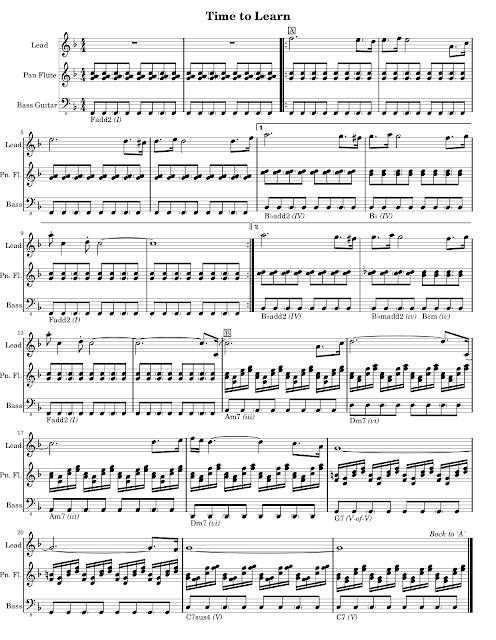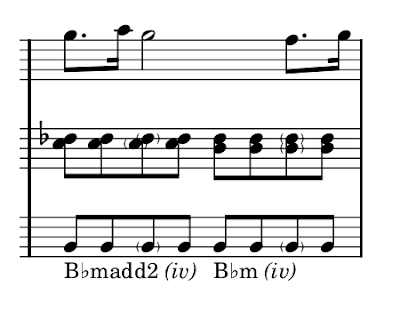 |
| "Time to Learn" transcription (Click to enlarge) |
Flash Player
This is the sweet little tune that plays during the tutorial segments, and it's appropriately low-key and outwardly uncomplicated. I really loved this tune as a kid (and still do!), and it demonstrates many sophisticated maneuvers beneath its deceptively simple exterior. Read on and join me as we put another tune under the microscope.
Harmony and Melody
We're in F Major, marking the first non-C key signature we've encountered in KSS, and the song form is fairly traditional: intro – A – A – B – back to A.
"A" Section
It's easy to see from a quick glance at the sheet music that the chords tend to take their time in the "A" section—in the first 6 bars we're treated to a single F chord! And yet it doesn't feel plodding, or overdue for a change, and a big reason why is that even though the overall harmony is pretty static, the specific notes hit change a little bit more frequently.
 |
| An Fadd2 piano chord |
Flash Player
Not to mention those super-slick add2 chords—known also as mu chords; they muddle up the chords a little and introduce a gentle dissonance to the proceedings—and they just sound great too. They're used in everything from jazz, to rock, to impressionism for color and their attractive thrumming quality.
You might be wondering if there's any difference on the second run through the "A" section. It's subtle, but it's there. Check out measure twelve:
 |
| Measure 12 extract |
The first time round the "A" section the harmony at this point (bar 8) was a simple B♭, but the second time (bar 12) we're treated to a B♭ minor. Playing a minor iv instead of the key's diatonic major IV is a pretty old trick actually, but the subtle use here (it's pretty easy to miss if you're not paying attention) makes it less of a cliche, not to mention the cliche-busting B♭ minor-add2 incarnation—that's one semitone's difference between the 2nd and the minor 3rd in this chord, allowing them to grate and butt heads for half a measure before resolving to a standard minor chord. That's some masterful use of dissonance, which is fast becoming a sort of calling card for this piece.
 |
| "A" melody |
And speaking of using dissonance, the "A" section's melody has a sprinkling of accidentals throughout that serve as fleeting departures from the key, preventing a strict adherence to the diatonic scale. It would've been just as easy not to use them, but it's little touches like these that add lasting interest to a composition and make the melody memorable and distinct.
"B" Section
The "B" section meanwhile, is a perfect contrast to the "A". The pan flute accompaniment ditches the ghost notes (more on those below), and starts playing a constant stream of 16th notes versus the "A"'s 8th-note rhythm.
 |
| "B" melody |
On top of that, the melody is at its most legato, with long, flowing notes dominating. And while I've chosen roman numerals relative to F major during the "B" section, the prevalence of minor chords at the beginning of the section makes it gently lean towards D minor, F major's relative minor. More contrast—very important!
Harmony-wise it's pretty standard stuff, though the turnaround at the end deserves some attention. We hit a G7 in measure 19—the only non-diatonic chord in the "B" section. For those wondering, it's what's termed a secondary dominant; its main purpose is to lead to the upcoming C7sus4 chord as if it were the I. And speaking of, the following C7sus4 is a textbook example of delaying the onset of the unaltered C7, which rockets us back to the "A" section's Fadd2.
Arrangement
The arrangement is fairly static, though the lead instrument changes each section; pan flute on the first "A", organ on the second, and some kind of synth voice during the "B" section. Kirby Super Star has a steadfast philosophy to change up the lead instrument fairly often, as it does here, and we'll see further evidence of this as we continue through the game. But needless to say it's another of those little details that elevate the lasting interest of its music. And just like last time, the ensemble is filled out by KSS's signature pan flutes and a bass guitar too.
Let's talk about ghost notes for a second. Essentially, they're notes played at a significantly lower volume than non-ghost notes, and exist to keep the momentum going. Their function leans more towards the rhythmic rather than melodic or harmonic. I've enclosed them in parentheses in the sheet music, and you can see that this piece absolutely loves them.
The main rhythmic "signature" of the piece is this figure:
 |
| "Time to Learn"'s rhythmic signature |
Flash Player
Sound about right? But even though this is essentially the rhythm we'd hum to ourselves when remembering this piece ("dum dum — dum dum dum — dum"), there's a lack of momentum, the drive jerking a bit during the rests. This is where ghost notes come in:
.png) |
| "Time to Learn"'s rhythmic signature with ghost notes added |
Flash Player
That sounds much better, even if the difference is subtle. This is a super simple use of ghost notes, but it really adds a lot. Of course this is nothing new to percussionists: ghost notes are their bread and butter. But "Time to Learn" uses them well, and they're in both the bass line throughout the entire composition, and in the accompanying pan flutes throughout the "A" sections, maintaining the momentum throughout the piece and adding a very natural, "live" feel to the proceedings.
Last Thoughts
A lot of people might skip this tune when playing the game, what with it underscoring an optional tutorial segment, but we've seen that this piece is another worthy track written with careful consideration, attentive design, and distinctive choices. Join me next time as we continue to break down Kirby Super Star's music, and start on the sub-game Spring Breeze:
_______________


No comments:
Post a Comment